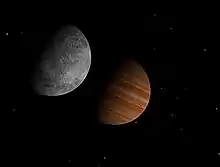HD 154345 b
HD 154345 b, is a Jupiter-sized extrasolar planet orbiting the star HD 154345.
 Planet HD 154345 b (min mass ~1 MJ) in the background with two hypothetical moons visible. Image was created with Celestia V1.41 using a custom map for the Planet and its moons | |
| Discovery | |
|---|---|
| Discovered by | Wright et al. |
| Discovery site | United States |
| Discovery date | March 12, 2006 (confirmed: May 27, 2007) |
| radial velocity | |
| Orbital characteristics | |
| Apastron | 4.33 AU (648,000,000 km) |
| Periastron | 4.03 AU (603,000,000 km) |
| 4.18 AU (625,000,000 km) | |
| Eccentricity | 0.036 ± 0.046 |
| 3322 ± 93 d 9.095 y | |
Average orbital speed | 13.7 |
| Inclination | 50+40 −26[1] |
| 2,453,230 ± 330 | |
| 113 | |
| Semi-amplitude | 14.28 ± 0.75 |
| Star | HD 154345 |
| Physical characteristics | |
| Mass | 1.2+1.3 −0.4[1] MJ |
Discovery
Wright et al. discovered the planet in March 2006 using the radial velocity method to detect the small wobbling movement of the star caused by the gravity of the planet. The discovery was confirmed in May 2007.[2]
Characteristics
The planet has a mass at least slightly less than that of Jupiter. It orbits its parent star at the distance of 4.18 AU. Its orbital period is about 9.095 Earth years and its orbit is circular. There are no interior planets of minimum mass (m sini) greater than 0.3 Jupiter.[3] Jupiter-like planets with these orbital and system characteristics are unlikely to be perturbed from the star's inclination.[4] Since the star's inclination is known as around 50°, this would make the planet's most likely mass greater than Jupiter's mass but less than twice that mass.[5]
As such HD 154345 b is presumed to be a gas giant "Jupiter twin".[3] Depending on composition the two planets may be around the same size, or HD 154345 b may be larger. This planet may also harbor a system of moons and rings.
See also
References
- Simpson, E. K.; et al. (November 2010), "Rotation periods of exoplanet host stars", Monthly Notices of the Royal Astronomical Society, 408 (3): 1666–1679, arXiv:1006.4121, Bibcode:2010MNRAS.408.1666S, doi:10.1111/j.1365-2966.2010.17230.x
- Wright, J. T.; et al. (2007). "Four New Exoplanets and Hints of Additional Substellar Companions to Exoplanet Host Stars". The Astrophysical Journal. 657 (1): 533–545. arXiv:astro-ph/0611658. Bibcode:2007ApJ...657..533W. doi:10.1086/510553.
- Wright, J. T.; et al. (2008). "The Jupiter Twin HD 154345b". The Astrophysical Journal Letters. 683 (1): L63–L66. arXiv:0802.1731. Bibcode:2008ApJ...683L..63W. doi:10.1086/587461.
- Roberto Sanchis-Ojeda; Josh N. Winn; Daniel C. Fabrycky (2012). "Starspots and spin-orbit alignment for Kepler cool host stars". Astronomische Nachrichten. 334 (1–2): 180–183. arXiv:1211.2002. Bibcode:2013AN....334..180S. doi:10.1002/asna.201211765.
- "hd_154345_b". Extrasolar Planet Encyclopaedia. Retrieved November 12, 2012.
